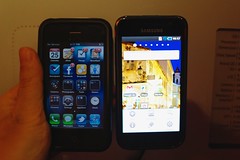Marvell has supported OLPC since the beginning, they have thus far provided the WiFi Meshing modules on XO-1 and XO-1.5. Marvell co-invested with Google, News Corp, Novell and the others into the founding of OLPC to bring about the XO-1 which forced Intel and the whole laptop industry to respond with the 100 Million netbooks that have been sold in the last 3 years to limit the effects of OLPC’s potential disruption of the laptop market. Marvell and OLPC have now signed an agreement in which OLPC is to develop XO-3 Tablet(s) based on one of Marvell’s ARM System On Chip processor solutions.
Marvell can justify the investment as an R&D investment in which everything OLPC develops, as all OLPC hardware designs are open source, can freely be used by Marvell’s manufacturing OEM partners to also release commercial tablet products based on these technologies.
OLPC will use these funds to develop the Tablet that can be used for productivity, for constructionist learning as Nicholas Negroponte said at the Mobilize 2010 conference last week:
How do you make tablets a constructionist medium? A medium where you make things, you don’t just consume them. Cause if it’s about kids and learning, it’s not like you feed a goose grain to make the foie gras. You have to make it for kids to use it, to make, to communicate. Whether it’s music, whether it’s text or whether it’s to write computer programs. And it has to be so low power, when it runs out of power you just shake it a little bit and it continues.
These are the challenges that OLPC will work on to implement in XO-3 before the target 2012 $75 release:

Why should children use tablets instead of laptops?
The future of OLPC: it’s a notepad.

The notepad is the oldest tool used by children in the class room. Imagine adding full online and offline interactivity to the notepad. Imagine a magic notepad that can display every page from every book, every image and every video ever filmed. To display low bitrate tutorial videos that work even in black and white mode like the ones of the Khan Academy, even have them be interactive and provided as learning games. The student can annotate all books, take notes and share them. The tablet is not only lighter and could be designed for cheaper, it also is the more usable form factor as an e-reader for reading all books ever written in the world. As Nicholas Negroponte says:
There is no way to justify a paper book. If you’d want to send 10 thousand physical books, you’d have to take every 747 out of service around the planet just to move them from wherever they are being manufactured. Physical books are a luxury.
I wonder if 7″ or 10.1″ Pixel Qi will be used, or both. The 7″ size may be optimal for it to be as light, cheap and durable as possible, it might be better for children to read books on a 7″ form factor than a 10.1″ one. For productivity, I think it should support both touch screen and some cheap $2 USB keyboards/mouse and use its built-in kick-stand. Children can easily carry a $2 keyboard/mouse when they need to be most productive. Maybe a thin keyboard to double as screen protector and which can be clipped onto the back of the device when in tablet/e-reader mode could be a nice design feature, although the screen needs to be unbreakable enough for children not to need worry about carrying the tablet without a screen protector.
For software, I think that OLPC should work with Google and the emerging tablet industry to customize Android for education. Maybe add Sugar apps support on top of Android OS as a secondary app platform “module layer” on top of Android. Basically, Sugar could be a custom UI layer on top of Android for the XO-3 tablet.















